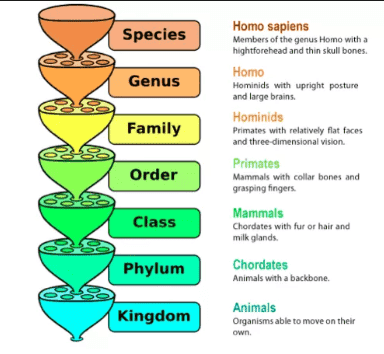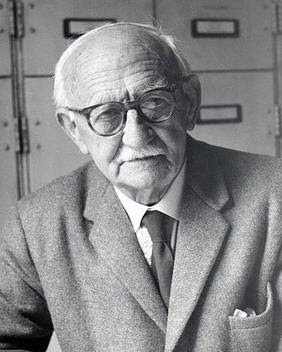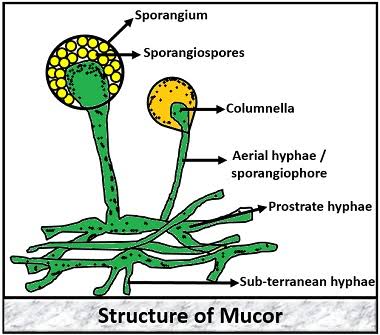The sporophyte of bryophytes start from simplest organization of Structure to the highest complex structure of different genus of bryophytes. The complexity is due to the progressive sterilization of the potentially of fertile cells (Bower), which result in the formation of different types of sterile tissue system in the Sporophyte. The simplest Structure of Sporophyte is seen in genus Riccia in which almost all the sporogenous cells are fertile and proceeded to the highest complex form of Sporophyte found in the genus funaria in which only a single layer of cells is fertile and most are sterile to form the complex structure.
The detailed comparisons of complexity of the Sporophyte of bryophytes are as follow-
(a) Riccia Bryophytes- In Riccia, zygote divides and redivides to farm a mass of spherical mass of 20-30 undifferentiated cells. Periclinal segmentation forms an inner mass of cells called endothecium and outer single layer amohithecium. The amohithecium single layered capsule wall. The endothecium forms the central mass of sporogenous tissue.
Practically, all the sporogenous cells are fertile and develop into spores. However, few of them undergo degeneration to form the nurse cells.
The Sporophyte of Riccia is the simplest among all the bryophytes and has the least amount of sterile cells. The entire embryo froms the spore producing capsule. There is not foot and Seta. It is just a spore producing organ without any distributing function.
(b) Marchantia Sporophyte- Sterilization of the fertile cells is more advanced in the genus. Half of the embryo derived from the hypobasal regions remain sterile. It forms the foot and Seta. The upper epibasal half of fertile and form the spore producing capsule. The sterile cell elongate , develop spirally thickened walls and become the elators. A few of the cells of sporogenous cells at the top may differentiate into sterile, apical cell.
The capsule of Marchantia has both spore producing and spore distributing body. It illustartes a step further in the progressive sterilization of the sporogenous tissue.
(c) Anthoceros Sporophyte- It's illustrates a step further than Riccia and Marchantia in the progressive sterilization of the potentially of fertile tissue. The endothecium cells become completely sterile and forms a group of cells is known as columella. The sporogenous cells arise from the Innermost layer of amphithecium. It's surrounds the columella. The sporogenous cells become differentiated into spore mother cell and pseudo-elaters. The archesporium of anthoceros is extremely reduced. The outer amohithecium develops into several cells layer thick capsule wall. The capsule wall develops a well ventilated photosynthetic tissue protected by the Epidermis.
(d) Funaria Sporophyte- In funaria, major portion of the Sporophyte remains sterile to form the foot and Seta. The capsule is diffrentiated into central column of endothecium surrounded by many layer of amphithecium. The inner layer of endothecium forms the sterile columella and the superficial cells forms the sporogenous tissue. Thus the archesporium arise from the outermost layer of cells of the endothecium. It is thus extremely reduced and consists of single layer of fertile tissue. The amphithecium become differentiated into the Epidermis, the photosynthetic tissue of the capsule wall and the outer spore sac.
This from the above discussion, it is clear that the Sporophytes of bryophytes become more and more complex in upward direction because of the gradual sterilization of the fertility of sporogenous tissue.
The detailed comparisons of complexity of the Sporophyte of bryophytes are as follow-
(a) Riccia Bryophytes- In Riccia, zygote divides and redivides to farm a mass of spherical mass of 20-30 undifferentiated cells. Periclinal segmentation forms an inner mass of cells called endothecium and outer single layer amohithecium. The amohithecium single layered capsule wall. The endothecium forms the central mass of sporogenous tissue.
Practically, all the sporogenous cells are fertile and develop into spores. However, few of them undergo degeneration to form the nurse cells.
The Sporophyte of Riccia is the simplest among all the bryophytes and has the least amount of sterile cells. The entire embryo froms the spore producing capsule. There is not foot and Seta. It is just a spore producing organ without any distributing function.
(b) Marchantia Sporophyte- Sterilization of the fertile cells is more advanced in the genus. Half of the embryo derived from the hypobasal regions remain sterile. It forms the foot and Seta. The upper epibasal half of fertile and form the spore producing capsule. The sterile cell elongate , develop spirally thickened walls and become the elators. A few of the cells of sporogenous cells at the top may differentiate into sterile, apical cell.
The capsule of Marchantia has both spore producing and spore distributing body. It illustartes a step further in the progressive sterilization of the sporogenous tissue.
(c) Anthoceros Sporophyte- It's illustrates a step further than Riccia and Marchantia in the progressive sterilization of the potentially of fertile tissue. The endothecium cells become completely sterile and forms a group of cells is known as columella. The sporogenous cells arise from the Innermost layer of amphithecium. It's surrounds the columella. The sporogenous cells become differentiated into spore mother cell and pseudo-elaters. The archesporium of anthoceros is extremely reduced. The outer amohithecium develops into several cells layer thick capsule wall. The capsule wall develops a well ventilated photosynthetic tissue protected by the Epidermis.
(d) Funaria Sporophyte- In funaria, major portion of the Sporophyte remains sterile to form the foot and Seta. The capsule is diffrentiated into central column of endothecium surrounded by many layer of amphithecium. The inner layer of endothecium forms the sterile columella and the superficial cells forms the sporogenous tissue. Thus the archesporium arise from the outermost layer of cells of the endothecium. It is thus extremely reduced and consists of single layer of fertile tissue. The amphithecium become differentiated into the Epidermis, the photosynthetic tissue of the capsule wall and the outer spore sac.
This from the above discussion, it is clear that the Sporophytes of bryophytes become more and more complex in upward direction because of the gradual sterilization of the fertility of sporogenous tissue.
 |
| Source Wikipedia |












0 Comments
If you have any query let me know.